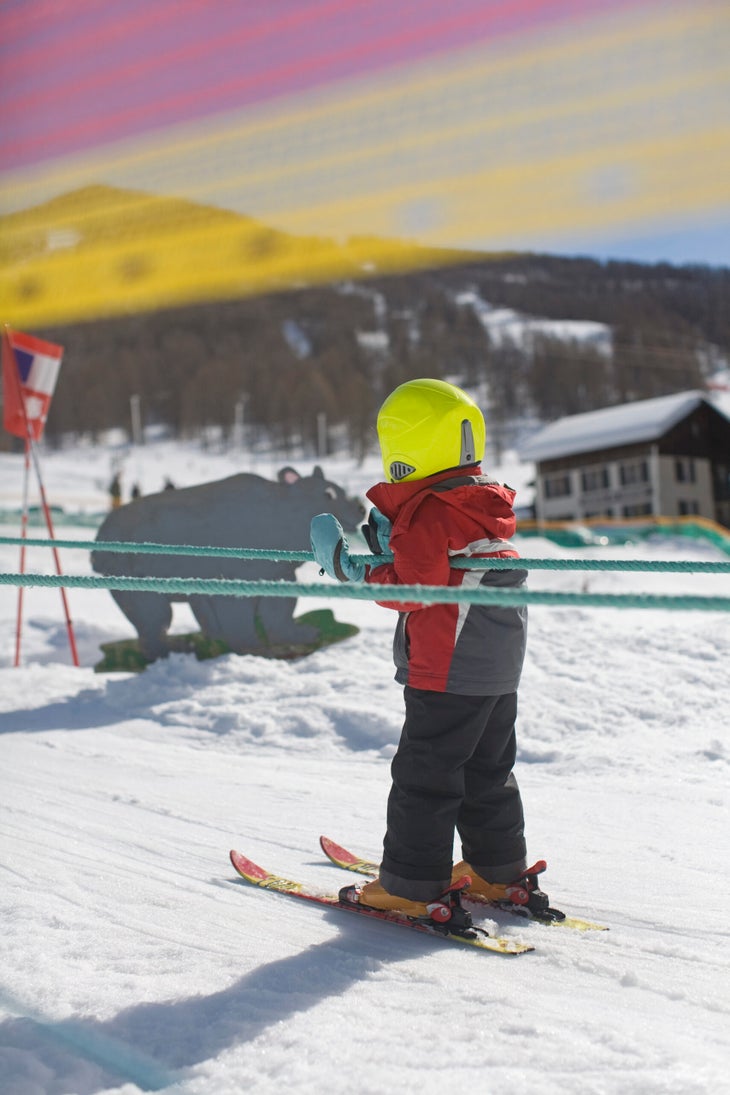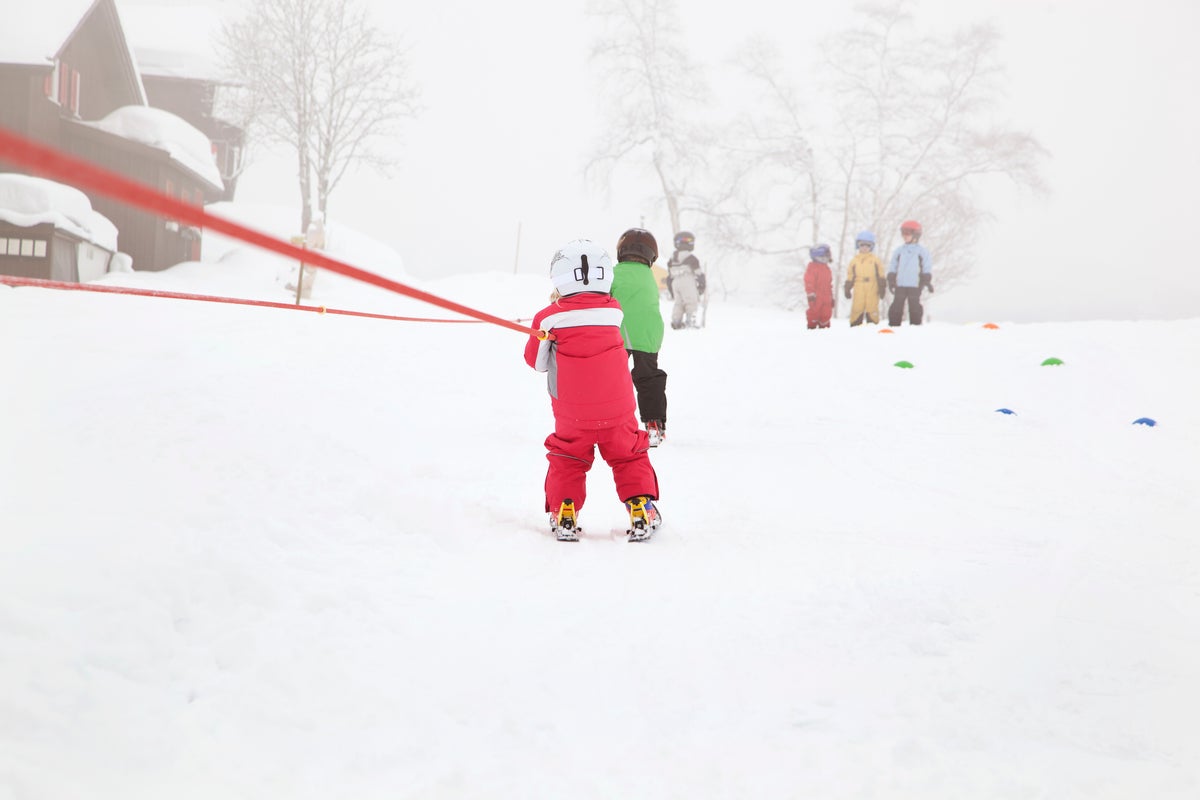Products You May Like
Last winter, I found myself standing at the base of the hill I skied as a kid. I was there partly out of convenience—I had just had a baby and the nearest destination resort is an hour’s drive from my house. It was also partly out of a desire to rediscover my joy for a sport that had started to sour for me: The soul-sucking commute, the $26 on-mountain grilled cheese, and the ever-growing crowds had taken a toll.
My hometown hill has none of that, but it also isn’t much to look at. It’s one run accessed by a single rope tow. There’s no snowmaking, so it’s typically dotted with orange cones marking rocks and patches of dirt. Ski clothing is mismatched, oversized, or nonexistent, and the on-mountain dining is whatever’s in your cooler. There’s no lift ticket or cost of any kind, and the rope whirrs seven days a week, weather dependent.
A winter at the rope tow was everything I needed after decades of resort skiing. Skiing is, after all, just the act of making turns down the side of a snowy mountain on skis. It doesn’t have to be complicated—or expensive. In fact, there’s something about the rope tow that really distills the sport down to its essence: Defying gravity to get pulled up the hill, then using that same same force to get back down. It’s reassuringly simple.
Also Read: No Pass? No Problem. Lift Tickets Are As Low As $49 At These Ski Areas
More and more resorts are turning toward these basic surface lifts to access their slopes. They’re millions of dollars cheaper to install, don’t require the massive effort it takes to put in a chairlift, and are accessible to beginners, without whom we can’t grow our sport. This winter, Sunrise Park, Ariz., will run a rope tow to the summit of Cyclone Circle, at 10, 700 feet, which has been closed due to the decrepit state of the double chair that serves it. This season, the new lift will provide access to the terrain, which is a mix of greens, blues, and blacks.
Ski purists know that these surface lifts are the soul of skiing. They’re still around, if you know where to look. Here are some of the most notable rope tows still operating in the U.S.—including the single-run town hills like the one I grew up on, as well as larger resorts where the simple laws of gravity are still abided.
6 Ski Areas Where the Rope Tow Rules

Chapman Hill, Durango, Colo.
Part of what makes Chapman Hill so great is that it’s owned by the City of Durango, which goes out of its way to make skiing accessible. Lift tickets are $16 for adults and between $0 and $14 for kids, depending on age. Best yet, you can walk to Chapman from downtown Durango and the mountain has plenty of snowmaking to bolster its natural snowfall.
Chapman is small but steep, with a single, whirring rope tow that transports skiers to the top. The hill has been part of the Durango community since 1966 and the rope tow itself was used by 10th Mountain Division soldiers training for World War II. Other perks include night skiing (included in lift ticket price), a ski school, and a warming hut.
Powderhouse Hill, South Berwick, Maine
It’s all about community at Powderhouse Hill. The slope itself is owned by the Town of South Berwick and is completely maintained and operated by a team of volunteers. The single rope tow provides access to three trails—two intermediate and one beginner—and the price is just right: $5 per person, cash only.
Powderhouse relies completely on natural snow and is open Wednesday and Friday evenings and Saturday and Sunday afternoons, weather permitting. At the base, there’s a small lodge with a roaring fire and a snack bar.
Trollhaugen Outdoor Recreation Area, Dresser, Wisc.
There’s more than just rope tows at Trollhaugen, but the resort’s five rope tows give the mountain its down-home character. From the simple surface lifts you can access all three terrain parks and a handful of beginner, intermediate, and expert runs. And with a little boost from the mountain’s double chair and two quads, skiers can explore all of Trollhaugen’s 24 runs.
The mountain also has a serious snowmaking operation, night skiing, a stunning lodge, and that unpretentious Midwest vibe. Adult lift tickets are $59 for the full day and $39 for night skiing only.
Ascutney Outdoors, Brownsville, Vt.
Ascutney has one of the coolest stories on snow: When Mount Ascutney Ski Area shut down in 2010, locals took matters into their own hands, partnering with the town and the Trust for Public Land to purchase the ski area—and a rope tow to keep the resort operational. A T-bar was added later, and combined, the two surface lifts provide access to eight trails and 26 acres of skiable terrain. But that’s not all. A skin or hike above the T-bar brings skiers to the upper slopes of the former ski area where backcountry skiing abounds.
Ascutney is open Saturdays and Sundays. A single-day lift ticket with full-mountain access is $20 for adults.
Buck Hill Ski Area, Burnsville, Minn.
Four rope tows dominate this 16-run ski area, providing access to everything from the half pipe and jibs to beginner terrain. Buck Hill, where Lindsey Vonn grew up carving GS turns across its 45 skiable acres, also has two quads and a triple chair.
A weekday adult lift ticket is $39 if booked online and $49 for weekends and holidays. Night skiing is $20. Don’t worry, the more expensive lift tickets come with more amenities: There’s tubing, a ski school, and a bar and grill with a fantastic deck. Plus, the entire operation is just 20 minutes south of Minneapolis.
Ski Northeast Slopes, Corinth, Vt.
Ski Northeast Slopes holds the title of the oldest continuously operating rope tow in the country, with a history that dates back to 1936. They take pride in the fact that they operate on real snow—no snowmaking here—and have lift ticket prices that encourage newbies to try the sport. Weekend and holiday skiing is $15 per person and on Wednesdays, lift tickets are $10. Ski lessons are by donation.
Around 12 trails are accessed by three surface lifts: two rope tows and one T-bar. And perhaps most notably, skiers get access to varied terrain—at Ski Northeast you’ll find everything from groomers to glades, plus a terrain park.
